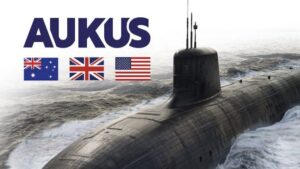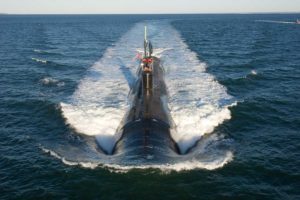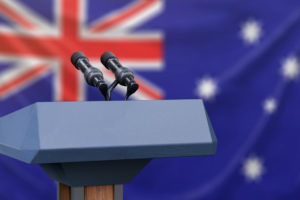[September 2022]
In April 2022, then-Prime Ministers Morrison and Johnson, along with President Biden, formally reviewed progress in implementing the new Australia-United Kingdom-United States (AUKUS) partnership. The leaders pointed to plans and recent achievements under both Pillar 1 (submarines) and Pillar 2 (advanced capabilities) of the AUKUS framework. Several successes were noted under each pillar, including:
- the Exchange of Naval Nuclear Propulsion Information Agreement (ENNPIA)[1], enabling AUKUS partners to share naval nuclear propulsion information trilaterally;
- an Australian commitment to establish a new naval base in eastern Australia;
- expansion of the Pillar 2 to include hypersonics, counter-hypersonics, and electronic warfare;
- identification of ways to more rapidly integrate commercial technologies to solve warfighting needs; and
- an agreement to combine emerging quantum technologies in trials and experimentation over the next three years.
The overall message was that AUKUS’ scope was expanding, especially in Pillar 2, and things were moving forward. Seventeen AUKUS working groups have been established to flesh out the cooperative details. Nine of these are under Pillar 1, and the remaining eight are under Pillar 2. However, there are still barriers to overcome in terms of policies, legislation, management structures, and information-sharing practices for AUKUS to reach its potential. These are worth understanding to keep expectations on all sides in check—especially in the United States and Australia—and to ensure that plans match reality.
AUKUS is, above all, a grand experiment between three like-minded and capable allies attempting to take collaboration and interoperability in advanced military capabilities and technologies to a new level in a way that existing structures, including Five Eyes (U.S., UK, Australia, New Zealand, Canada), have not.[2] If effectively implemented, AUKUS could become the springboard for revolutionizing how the United States works with a very select group of its most capable allies through an extraordinary depth of technological development, access to highly classified materials, expanded sharing of intellectual property, and, ultimately, shared supply chains in ways that benefit both the United States and its allies.
But AUKUS’ effectiveness depends in large part on the willingness of the United States to not only allow its closest wartime allies access to critical and sensitive technologies related to nuclear propulsion but to commit to the organizational and manpower resources needed to make AUKUS a success. This includes access to the requisite subject matter expertise; the ability to systematically identify, analyze, and manage challenges; and the employment of measurable indicators of success. These are not easy tasks, and each carries some risk, including the sensitivities of sharing commercial data and the requisite intellectual property agreements, which may require additional legislative attention and action. Meanwhile, the role of the private sector, and the complications therein, is an under-analyzed aspect of AUKUS.
Australia is clearly taking AUKUS seriously, and for good reason: AUKUS offers the potential for a step-change in its ability to shore up its regional capability advantage and its desire to invest in sovereign defense capabilities[3] as laid out in the 2020 Defence Strategic Update and associated Integrated Investment Program. The Australian Embassy in Washington will have a team of about 10 to 15 people to liaise with the Department of Defense (DoD) on AUKUS. In Canberra, the Office of the Prime Minister and Cabinet, Defence, and Foreign Affairs and Trade all have Band 3-level (deputy secretary) oversight and task forces dedicated to AUKUS, in part to help ensure that the issues and projects identified by the 17 working groups receive attention at higher levels. But progress will depend on making headway on longstanding barriers to technology and industry cooperation, most especially National Technology Industrial Base reforms.
The enthusiasm is curtailed somewhat in the United States. Discussions with U.S. Defense officials can leave one with an impression of skepticism about what they think AUKUS can really deliver and when. One official explained the differences in expectations between the United States and Australia like this: “U.S. officials expect to use AUKUS to get issues raised to higher levels for discussion, but Australian officials expect to have doors opened and problems solved more immediately.”[4] They went on to add that disclosure and International Traffic in Arms Regulations (ITAR) require Congressional relief, which is (at least) a year-long process. Parliamentary systems like those in Australia and the United Kingdom are more streamlined and can generally move much faster.
In contrast to the manpower and high-level departmental oversight that Australia has devoted, especially in Defence, the United States and United Kingdom have fewer staff assigned to AUKUS and most are not dedicated full-time, instead splitting their attention between multiple pressing issues. The U.S. DoD has only a small fraction of staff in the Office of the Secretary of Defense apportioned to AUKUS compared to Australia, and most are not subject matter experts (SMEs) in the working group topics. That expertise lies elsewhere, which brings up a related issue—the potential role of the U.S. military services in the AUKUS analytic and decision-making framework. The military departments can be advocates for change in DoD structures, but they are one step removed from the inner workings of AUKUS. Currently, the U.S. military services aren’t particularly close to the issues being discussed in AUKUS. A U.S. Air Force official explained that the Air Staff cannot advocate for resolving issues if they aren’t formally in the loop. Another official remarked that the services have no control over AUKUS; they are only one voice, and no one is paying attention. Moreover, the same people working on AUKUS are also serving on the bilateral committees (which cover roughly the same topics) and tend to have a bilateral mindset for problem-solving. Some question the need for AUKUS due to the existence of robust bilateral structures.
It is unclear how certain platforms and capabilities are intended to be discussed and studied within the AUKUS framework and there is currently no clear path for answering this question. AUKUS is probably better suited for those capabilities and platforms that all three allies share or wish to share, but further analysis is needed to create viable capability development pathways.
What does AUKUS need to overcome these challenges?
A robust AUKUS framework could be designed to allow innovation in artificial intelligence, quantum, and other key defense technologies to flourish. At its most fundamental, it needs all three parties to fully appreciate and buy into the idea that this arrangement benefits all of them. Due to its genesis, it may be that AUKUS is seen as primarily advantageous to Australia, when instead—taken to its full potential—the AUKUS whole can be greater than the sum of its parts.
At the political level, AUKUS needs clear support from leadership at senior levels and assurance from all three governments that they are paying attention to AUKUS. The success of the 17 working groups will greatly depend on active and continuous support. To be effective, the working groups must be empowered by strong leadership and must convene regularly, with purpose and outcomes in mind. It will be important for them to go beyond admiring the problems to identify solutions and workarounds, but only after they fully understand the issues.
Legislatures, particularly the U.S. Congress, also need to be kept abreast of the issues and challenges raised by the AUKUS working groups. The “AUKUS Caucus,” announced in April 2022, will likely be an important conduit. There is unconfirmed talk of establishing an AUKUS “Friendship Group” in Australia’s Parliament; there is no AUKUS Caucus equivalent in the UK parliamentary system, nor do they expect one to form in the near term.
At the bureaucratic level, AUKUS planners will need adequate resources, including a distributed governance framework with shared responsibilities and committed staff and funding. There should be careful consideration and clear boundaries that define projects to be worked through the AUKUS framework versus a bilateral approach.
Further, SMART (specific, measurable, actionable, results-oriented, time-bound) objectives and clear metrics should be developed to enable the progress of the working groups to be objectively evaluated. For example, meeting deliverable dates is an obvious and essential metric, as is consistent maintenance of meeting schedules and speed of decision-making. Progress in armaments cooperation is another metric and includes changing processes that facilitate innovation and deepening of cooperation. We have already seen mention of multi-year plans in AUKUS (reference the note above about quantum technologies). Those plans should include proposed projects, anticipated costs, and timelines for delivery reported annually. Platforms shared by all three allies, such as Wedgetail/E-7, MQ-28, and Joint All-Domain Command and Control (JADC2)/Air Battle Management System (ABMS), should feature prominently in this conversation.
Finally, the AUKUS apparatus needs access to technical SMEs and an empirical evidence base to properly fuel it. The involvement of the military services from each of the three countries, particularly the allied air forces under Pillar 2, could provide the expertise and dedicated staffing that is currently lacking (at least on the U.S. side). Air forces care deeply about new technologies, including synthetic training, autonomous systems, intelligence/surveillance/reconnaissance, cyber and hypersonics, as well as operational support capabilities such as agile combat employment and base defense. In the near future, there could even be additional AUKUS pillars that involve the services more directly to focus on their specific interoperability challenges.
For AUKUS to assuage the skeptics, it will be important in the next six months to generate some tangible early “wins,” build momentum, and even exceed expectations. It will be important to demonstrate the utility of AUKUS in facilitating a broader defense relationship by laying out a realistic, clear-eyed vision for the partnership; establishing a framework and plan to manage the work; identifying and addressing barriers; and ensuring that metrics are in place to track progress. Doing so may well shine a light on the existing barriers to collaboration—technical, bureaucratic, budgetary, cultural, regulatory, political, and strategic. This will not be comfortable or easy—some of these barriers are deeply entrenched and difficult to alleviate. But the prize in getting AUKUS off the ground isn’t just in major benefits to the allies and their respective regions; rather, it’s in the potential for AUKUS and relationships like it to help the United States achieve what it wants in a world becoming more challenging with each passing year.
[1] The ENNPIA entered into force on February 8, 2022.
[3] Sovereign capabilities refer to a country’s desire to enhance its ability to develop, maintain, and employ its own defense capabilities.
[4] Author discussions with Senior Department of Defense official who is tracking AUKUS activities, July 2022.
[5] This could be an initiative for the Congressional AUKUS Working Group (the AUKUS Caucus) to consider in addition to the recent legislation on the submarine officer training pipeline.









